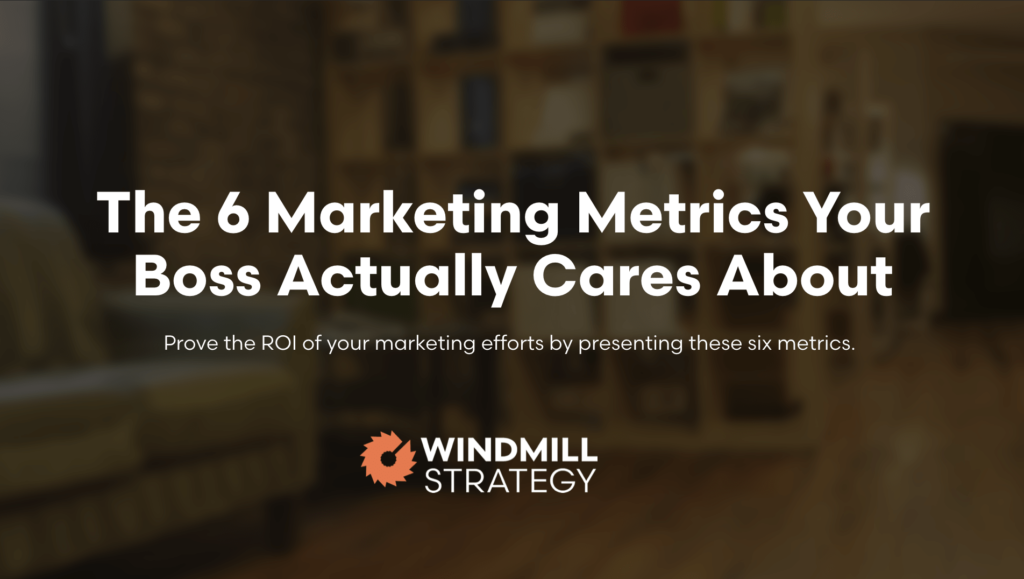Keep it Simple With These Essential B2B Marketing Metrics

If you’re part of a small marketing team in a B2B sales-driven business, you know what it’s like to be continuously pulled in different directions while helping to grow your company. Indeed, you might have a vision for where marketing can go in your organization but lack the time, expertise, or plan of attack to make substantial progress.
At the same time, you’re wrestling with an overwhelming collection of marketing metrics that you could use to measure progress and prove to the boss how your innovative strategies are growing the business. You know that by tracking and reporting the right KPIs (key performance indicators), you can prioritize your tactics and show a compelling link between your marketing spend and business results.
But which metrics or KPIs should you track? For the answer to that question, you could dig through an avalanche of online articles explaining scores of metrics in ad nauseam
… or simply keep reading.
To help you sort through these sometimes bewildering options, we divide marketing metrics into two distinctive groups:
1. Metrics that help you improve marketing effectiveness.
2. Metrics that help you prove and increase ROI.
Regardless of where you begin, knowing which metrics to measure, prioritize and improve will help you cut through the noise and focus on activities that’ll make the most significant impact. Let’s break it down.
3 Metrics That Help You Improve Marketing Effectiveness
These metrics help you understand who’s coming to your website. Are they the right people? Are they engaged? Are they converting into leads, and are they leads your sales team can close? Marketing effectiveness metrics are also associated with activities concerning acquisition, behavior and outcomes.
First off, if your company employs an account-based marketing strategy (ABM), or if you’re targeting specific geographies, ensure you’re focusing analytics on those areas. For instance, if you sell only within the U.S., set Google Analytics to show traffic, bounce rates, engagement, and others within the U.S. only. If you’re most focused on specific regions like the Midwest or Northeast, be sure to set up custom segments.
Additionally, if there are a few countries or continents you don’t care about, filter those out from a worldwide view. Finally, always filter out your internal IP addresses at the corporate office, and acquire as many home IP addresses as possible from sales and marketing staff that frequently view the site from their home office.
1. Acquisition: When establishing acquisition metrics, what ultimately matters is which channels drive the most conversions that convert into sales. And of those, the sales of the highest value to your organization?
Is your organic site traffic driving leads and qualified prospects, or are visitors reading old press releases that are no longer relevant? Unless search traffic is coming to old or irrelevant content, organic traffic growth is also a strong signal that your SEO (search engine optimization) strategy is working. When your website’s organic traffic grows, it naturally increases the number of prospects that find your site through search engines. Moreover, as the search tool company SpyFu* explains it, an increase in traffic is also a leading indicator that your website houses valuable content.
For more on what you can do to increase organic traffic, read SpyFu’s “10 SEO Goals You Should Target in 2020.”
Is your Adwords traffic generating quality leads? What ads, campaigns, keywords, days, times are working and not working? Be sure you measure conversions correctly with appropriate attribution models* (often position-based is the most accurate for B2B), and then measure where the conversions come from. Then, check your deal quality/attribution reporting to make sure that conversions are resulting in quality deals. What patterns do you see about the quality conversions vs. the non-converting ads, campaigns, keywords, or other attributes? Experiment to double down on what works and cut out what’s not directly driving sales.
For more on attribution models, read this insightful article by Google
Are your social media campaigns delivering quality leads or job applicants? Facebook likes are not an accurate measure of B2B success, and we generally recommend doubling down on getting your website performing well before spending too much time in social
2. Behavior: This category of metrics tracks the activity of your website visitors. Are they clicking on CTAs, browsing other pages, and making it to your contact or get a quote page? Other common behaviors are engagement indicators, which include time on site, average pages per session and bounce rates.
If you’re experiencing low engagement across your website, heed StoryBrand Donald Miller’s advice: “Fix the homepage first.”
A thorough analysis of SEO performance will also help you see which pages are getting the most traffic within your target geographies. How can you improve the pages so that the message is focused around your positioning? Further, what changes can you make to those pages that will help generate more leads?
3. Outcomes: Here is where you track the impact of your marketing campaigns and programs. For instance, how many quality leads did your website deliver in a given period? Look at a long set of data to allow for extended lead cycles and research periods. TTM (trailing twelve months) should account for seasonal differences, but the last 30 days likely reflects recent changes that you’ve made to the current pipeline. As a B2B company, prioritize quality leads over traffic metrics, even conversion rates or bounce rates.
If your website is built to support B2B sales, your objective should be moving and motivating your prospects to complete a form — such as a quote request. However, we only care about form completions from qualified leads that represent who you’re most likely to win in the sale. Where are your current successes coming from? Track all your leads that come from the website; what sources, what ads and what geographies? What days of the week, time of day? Additionally, identify sources that are generating poor quality leads or nuisance leads. These are the leads that consume your time but show little promise of converting into customers because they’re unqualified.
Finally, how can you use your data to double down on what’s working and cut out what’s not?
6 Metrics That Help You Prove ROI
Hubspot says there are six marketing and sales metrics that senior business leaders most care about. From our experience working with B2B companies for years, we agree. What’s more, since studies reveal that 73 percent of executives don’t believe marketing drives demand and revenue, you have a lot of work to do to assuage your sales leaders’ biases.
Here are the six metrics that matter the most to your sales and marketing teams:
1. Customer Acquisition Cost (CAC): Use the CAC to quantify how much you spend to acquire a new customer. To calculate, total your sales and marketing spend over a period (e.g., monthly) and divide by the number of new customers for that period.
2. Marketing Percentage of Customer Acquisition Cost (M%-CAC): This is the marketing component of your total CAC. You calculate it as a percentage of the overall CAC. To calculate, total your marketing costs then divide by your total sales + marketing costs that you used to figure CAC.
3. The Ratio of Customer Lifetime Value to CAC (LTV: CAC): This vital ratio considers the lifetime value of each of your customers compared to how much money you spend to acquire that customer. To calculate the ratio, you’ll need first to estimate the customer’s lifetime value and know your CAC.
4. Time to Payback (CAC): This metric reflects the number of months it takes to recover the CAC expended to acquire a customer. To calculate, start with the CAC and divide it by the margin-adjusted revenue per month for each new customer. The result is the number of months it will take to pay back your initial investment.
5. Marketing-Originated Customer Percentage: Calculate the metric by determining which portion of your total customer acquisitions originated through marketing programs. To calculate, add up all newly-acquired customers over a fixed period such as 30 or 90 days and determine what percentage originated from a marketing lead.
6. Marketing-influenced Customer Percentage: To calculate this metric, analyze your total number of new customers over a set period. Determine which of these customers came into contact with any marketing tactics or campaigns during that period. That result is your marketing-influenced customer percentage.
Are you looking for even more ROI-focused marketing metrics? Read this article from SearchEngine Journal
BONUS: For more detail, formulas and calculations behind the six metrics that help you prove ROI, fill out the form below to download this short slide deck.



